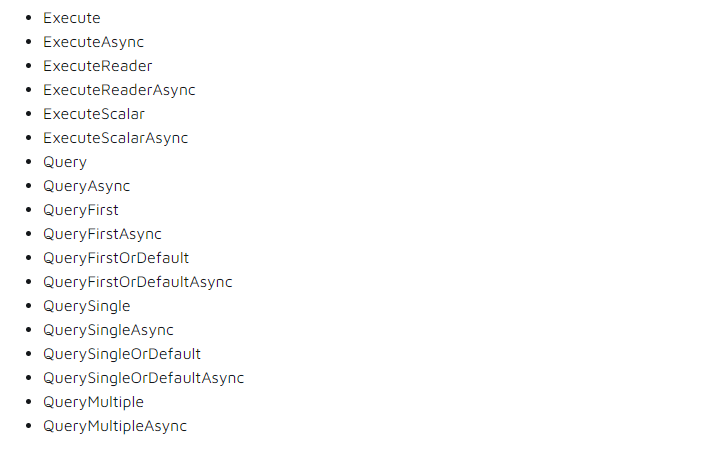让Dapper更强的插件 标签 标签
- 一句话的事儿:
0. 前言
在前一篇中我们讲到了Dapper的应用,但是给我们的感觉Dapper不像个ORM更像一个IDbConnection的扩展。是的,没错。在实际开发中我们经常用Dapper作为对EF Core的补充。当然了Dapper并不仅仅只有这些,就让我们通过这一篇文章去让Dapper更像一个ORM吧。
1. Dapper Contrib
Dapper Contrib 扩展了Dapper对于实体类的CRUD方法:
安装方法:
命令行:
dotnet add package Dapper.Contrib
NuGet:
Install-Package Dapper.Contrib
使用:
using Dapper.Contrib.Extensions;
这个是一个使得Dapper功能更强大的扩展包,因为支持了CRUD,所以需要对实体类添加配置,该扩展包使用Attribute作为依据进行相关映射配置:
[Table("Model")]public class Model{[Key][ExplicitKey]public int Id{get;set;}[Computed]public int Count {get;set;}[Write]public String Name{get;set;}}
这是所有的配置,Table用来声明是一个表,必须指定表名,Key表示该属性是数据库主键,ExplicitKey表示这个属性是数据库中显示设置的主键,Computed表示该字段是一个计算字段,Write表示该字段可以设置值进去。需要注意的是: Key和ExplicitKey这两个不能同时标注在一个属性上。
那么接下来,我们看看它扩展了哪些方法:
插入单个对象:
public static long Insert<T>(this IDbConnection connection, T entityToInsert, IDbTransaction transaction = null, int? commandTimeout = null) where T : class;
其中 transcation表示事务,如果指定事务,数据的提交将由事务控制,该方法会返回插入对象的主键(如果对象主键是数字类型)或者返回一个待插入列表中已插入的行数。
获取单个对象:
public static T Get<T>(this IDbConnection connection, [Dynamic] dynamic id, IDbTransaction transaction = null, int? commandTimeout = null) where T : class;
通过传入主键,获取一个数据
获取所有数据:
public static IEnumerable<T> GetAll<T>(this IDbConnection connection, IDbTransaction transaction = null, int? commandTimeout = null) where T : class;
更新数据:
Dapper Contrib 提供了一个用来更新的方法:
public static bool Update<T>(this IDbConnection connection, T entityToUpdate, IDbTransaction transaction = null, int? commandTimeout = null) where T : class;
这个方法比较有意思的是
var entity = connection.Get<Model>(1);entity.Name = "测试1";connection.Update(entity);
和
var models = connection.GetAll<Model>();foreach(var m in models){Console.WriteLine(m);m.StringLength ++;}connection.Update(models.AsList());
都可以,并不会报错。
不过需要注意的是,如果需要更新的实例没有指定主键值(主减属性没有赋值),则不会有任何行发生更新。而且在更新的时候,会更新所有列,不会因为不赋值就不更新。
删除方法有两个:
public static bool Delete<T>(this IDbConnection connection, T entityToDelete, IDbTransaction transaction = null, int? commandTimeout = null) where T : class;public static bool DeleteAll<T>(this IDbConnection connection, IDbTransaction transaction = null, int? commandTimeout = null) where T : class;
删除也是传入一个实体类,一样也只是需要主键有值,如果没有找到主键对应的数据,则不会有任何变化。Delete与Update一样,如果传入一个List集合也是可以的。
2. Dapper Transaction
这个包扩展了Dapper的事务处理能力。虽然是Dapper的扩展包,但是是给IConnection添加了一个扩展方法。使用示例如下:
dotnet add package Dapper.Transaction
老规矩,记得先把包加进来。
然后代码是这样的:
using Dapper.Transaction;
using(var connection = new SqliteConnection("Data Source=./demo.db")){connection.Open();var transcation = connection.BeginTransaction();// 编写业务代码transcation.Commit();}
如果使用Dapper Transaction,需要先调用 connection.Open()来确保连接是开启状态。
transcation这个对象可以当做普通的DbTranscation对象,传给Dapper的方法来使用,也可以当做一个开启了事务的Dapper客户端来使用。也就是说,Dapper对IDbConnection扩展的方法,在这个包对IDbTranscation也扩展了响应的方法:
3. Dapper Plus
这个插件是Dapper上用来处理巨量数据的插件,但这是个收费版的插件,不过每个月都有一定的试用期限。想试试的可以下一下:
dotnet add package Z.Dapper.Plus
使用:
using Z.Dapper.Plus;
这个插件在使用之前需要先配置实体类与数据库之间的映射关系:
DapperPlusManager.Entity<Customer>().Table("Customers");DapperPlusManager.Entity<Supplier>().Table("Suppliers").Identity(x => x.SupplierID);
该插件支持四组大批量处理方式:
- Bulk Insert
- Bulk Update
- Bulk Merge
- Bulk Delete
// STEP MAPPINGDapperPlusManager.Entity<Supplier>().Table("Suppliers").Identity(x => x.SupplierID);DapperPlusManager.Entity<Product>().Table("Products").Identity(x => x.ProductID);// STEP BULKINSERTusing (var connection = new SqlConnection(FiddleHelper.GetConnectionStringSqlServerW3Schools())){connection.BulkInsert(suppliers).ThenForEach(x => x.Products.ForEach(y => y.SupplierID = x.SupplierID)).ThenBulkInsert(x => x.Products);}// STEP BULKUPDATEusing (var connection = new SqlConnection(FiddleHelper.GetConnectionStringSqlServerW3Schools())){connection.BulkUpdate(suppliers, x => x.Products);}// STEP BULKMERGEusing (var connection = new SqlConnection(FiddleHelper.GetConnectionStringSqlServerW3Schools())){connection.BulkMerge(suppliers).ThenForEach(x => x.Products.ForEach(y => y.SupplierID = x.SupplierID)).ThenBulkMerge(x => x.Products);}// STEP BULKDELETEusing (var connection = new SqlConnection(FiddleHelper.GetConnectionStringSqlServerW3Schools())){connection.BulkDelete(suppliers.SelectMany(x => x.Products)).BulkDelete(suppliers);}
4. 总结
这些插件让Dapper更强,也更具备一个完整的ORM的方法,当然实际开发中需要结合实际需求使用。可能并不是所有的都合适。
Dapper的内容就到此为止了。本来预计下一篇开始 asp.net core的内容,不过有个小伙伴推荐了FreeSql,我看了下感觉挺不错的,就给小伙伴们介绍一下~这一个介绍完成之后,就进入了我期待已久的asp.net core系列了。
- 本文作者:GeekPower - Felix Sun
- 版权声明: 本博客所有文章除特别声明外,均采用 MIT 许可协议。转载请注明出处!

